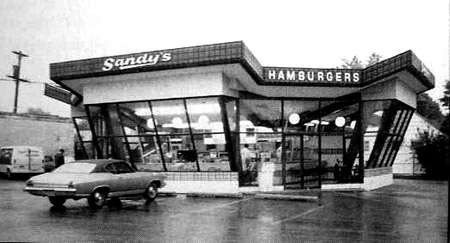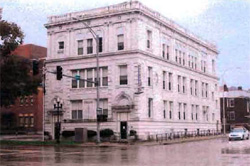Editor’s Note: The following editorial was written and submitted by Margaret E. Cousin, Vice-President of the Central Illinois Landmarks Foundation. It was also published as a Spotlight article that appeared in the Journal Star over the weekend. The views expressed by guest contributors do not necessarily reflect the views of the editor.
I talk a lot about buildings that sing. Their loveliness creates a special kind of music that stirs a powerful response in me. Most often it’s old buildings that do this. Perhaps this is because they have those special ingredients of historic importance and architectural uniqueness that evoke an awareness of and perspective on our past.
We all cherish family heirlooms and consider ourselves fortunate if they pass down to us. They are the remaining tangible evidence of people whose stories we know, who contributed to our own evolution of identity and character. Who among us would go into the attic of a beloved relative and throw treasures away without serious, measured regard for their intrinsic value and the consequences of their loss? Our city is no different. It is our larger family. It is our greater history. It has a legacy of its own.
During several glorious autumn weekends in 2009, I made the photo album and spreadsheet that identify some of the structures in Peoria with local designation potential. They represent a portion of our extant historic stock, an astounding percent having already been destroyed. As a CLG (Certified Local Government), Peoria is required to maintain an effective historic preservation program for the identification and protection of historic resources. Not only should such a survey have been done at some point in the last 20 years to fulfill our standing with the State of Illinois, but the survey process should be ongoing. This “list” wasn’t meant to target or threaten, although it was perceived as such and was, ironically enough, produced at the request of the City Council. It was meant to identify the most significant and meaningful of our structures. These examples, sprinkled throughout our core city and gracing our streetscapes, are the singular visual and cultural inheritance of our forefathers. They are the heirlooms in our attic.
The project stirred up such consternation that it helped trigger the events which resulted in the City Council’s February 8, 2011 vote to monumentally alter our historic preservation ordinance. The Council voluntarily relinquished its role in the necessary, active process of historic preservation, a process aimed at protecting our cultural heritage. Preservation accomplishes a very pertinent and vital goal, that of promoting tourism, assuring stable neighborhoods and enhanced property values via strong historic districts, and cultivating sustained economic activity in Peoria’s center. The decision to abdicate participation in anything other than mandatory owner consent landmark cases, which are by their nature benign rather than challenging, opened the door for demolition at will. Of any or all of our most noteworthy vintage elements, possibly too old-fashioned, too worn out, too costly to be viewed as viable by their present custodians. With such an ordinance in place, Easton Mansion would not have risen from its ashes like a phoenix under the loving care of Jane Converse, nor would the beautifully restored and successful adaptive reuse of the Musicians Hall, Busey Bank, grace Kumpf Boulevard.
By making no provision for any other entity to fill the footprints it has vacated, the Council also left a critical vacuum with no representative of the community’s interests able to act on behalf of those interests. Compounding this with the directive that put the “onus” for owner education on preservationists turned what had been a collaborative effort into a lonely endeavor moving forward. “Unpleasant burden” is the literal definition of that word, and it is discouraging to think of our designation efforts and achievements in those terms.
We will be as good as the best of our decisions or as mediocre as the worst. We will sink, or we will soar. Shall we be a city whose claim to fame is what we used to have? Sad, nostalgic mentions on one of the Peoria Historical Society’s delightful and educational trolley tours? I want my Peoria skyline to include inspiring profiles from the past as well as contemporary testaments to the future. I want my elected officials to aspire to take part in that process through a restored ordinance. Not just celebrating the landmark after someone else has persuaded and researched and presented it, but in concerted partnership to promote and preserve the surviving, remarkable historic resources we cannot afford to lose. Therein lies the true vision, the true victory. For the City Council, for preservationists, and for Peoria.


 The Peoria City Council denied historic preservation for the AMVETS building, 237 NE Monroe, at tonight’s council meeting. First district councilman Clyde Gulley moved to deny the request, seconded by at-large councilman Eric Turner. The vote was 9-1 in favor of Gulley’s motion to not landmark the building (Councilman Sandberg voted against; Councilman Jacob abstained).
The Peoria City Council denied historic preservation for the AMVETS building, 237 NE Monroe, at tonight’s council meeting. First district councilman Clyde Gulley moved to deny the request, seconded by at-large councilman Eric Turner. The vote was 9-1 in favor of Gulley’s motion to not landmark the building (Councilman Sandberg voted against; Councilman Jacob abstained). The City Council will vote Tuesday on whether to make the AMVETS building an historic landmark. The Historic Preservation Commission is recommending that they do. But it appears that even if the council ultimately votes against preserving the building, plans to move the AMVETS Post 64 to a new location are already kaput. Riverside Church has backed out of their purchase agreement for AMVETS’ current location, and the owners of the proposed new location — the old Penguin Tap in Peoria Heights — have moved on to another potential buyer for the property who offered more money.
The City Council will vote Tuesday on whether to make the AMVETS building an historic landmark. The Historic Preservation Commission is recommending that they do. But it appears that even if the council ultimately votes against preserving the building, plans to move the AMVETS Post 64 to a new location are already kaput. Riverside Church has backed out of their purchase agreement for AMVETS’ current location, and the owners of the proposed new location — the old Penguin Tap in Peoria Heights — have moved on to another potential buyer for the property who offered more money.